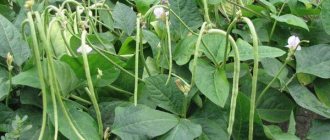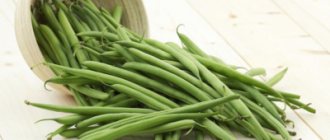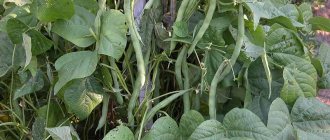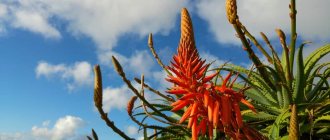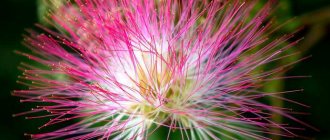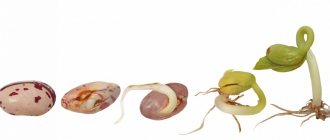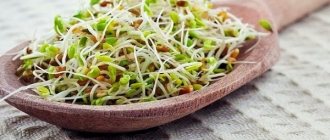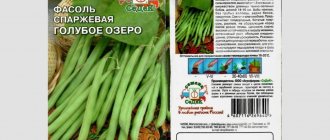Unusual, exotic plants have recently appeared more and more often on the garden plots and vegetable beds of our compatriots. most often these are crops that are well known to residents of tropical countries, where they live in natural conditions. Vigna also came to us from Africa, but even there it does not grow in the wild, but is grown as a grain, fodder, vegetable, and green manure crop. The composition of the fruit is rich in vitamins, minerals, and substances beneficial to human health. In addition, bright beautiful greenery, original flowers and hanging long “blades”, as the unripe fruits of cowpeas are called, can serve as a decoration for the garden and be used to create a hedge.
Vigna: what kind of plant is it?
Cowpea is a herbaceous plant not found in the wild that resembles beans in appearance. Crossing and pollination with beans is not possible. The annually planted cowpea can be in the form of a bush, climbing vine, tall or short. Some varieties are especially attractive when the flowers appear.
Cowpeas are popularly called “cow peas” or “sweet beans.”
The birthplace of culture is Africa. From there it spread to America and European countries. The plant is very popular in East Asian countries. In our country, the popularity of cowpea is only gaining momentum.
The blades of the crop are eaten when they are still at a young stage of ripening, and beans. The plant has a number of advantages due to its valuable composition.
How to grow cowpea
I’m comparing two options: I grew cowpea varieties “Countess” and “Dachnitsa” in the Kuban foothills, my good friend grew “Countess” and “Rowan Beads” in Komsomolsk-on-Amur. Both places are distinguished by an abundance of summer sun and warmth, but in Kuban the summers are drier and longer.
It is better to do the same with cowpea seeds as with beans: soak in relatively hot (+60 ºС) water. When the water has cooled, drain it almost completely, but leave it at the bottom. And put it in a warm place. I do this a day before planting.
How I grew cowpea in Kuban
Here, in Kuban, they love climbing beans (cowpeas are just starting to take root), and traditionally they plant a lot: tall, 3-meter thick stakes are stuck in rows and a pair of “beans” are planted next to them.
I decided to follow the advice of N.I. Kurdyumov and planted cowpeas and beans mixed with corn in a row on the southern side of the melon field. The experiment was not a success: where the corn sprouted, there were no beans, and where the cowpea sprouted, there was no corn. I had to stick the stakes in.
A little about the soil. Our clay is heavy. The melon patch is a fenced area in which the main components are foliage, shells, small twigs of the neighboring hazel tree, some soil from cleaning the drainage ditch, food waste stored all winter, ash and mown grass brought in from April to September. By the time of planting, everything is covered with freshly cut grass. She unrolled a strip of toilet paper over this grass, poured soil from molehills, and planted cowpeas, beans and corn in this soil.
She planted them in mid-May at the same time as planting watermelons and melons, for which she sprinkled heaps of molehill soil on top of the grass. I immediately covered everything with dry grass on top, because the birds are vigilantly watching all my actions. And in general there have already been precedents.
Vigna came to the surface within a week. And after another week we had to stick stakes in so that she would have something to grab onto. I watered all the plants once every two days - June turned out to be unusually dry and hot. In July the rains improved, and the cowpea grew further without additional watering. In the first ten days of July we already ate the pods. And they continued to eat until frost, although in October the cowpeas bore noticeably less fruit.
The fertilizing was mowed grass placed in the melon all summer.
In Komsomolsk-on-Amur
In Komsomolsk-on-Amur, planting was also done directly in the ground, but a little later - at the end of May, on the south side of the garage in rich garden soil. The bed is raised and well heated. The seeds were also pre-soaked in hot water. The shoots also appeared a week later and already in mid-June they were climbing with might and main over the stretched plastic mesh. Almost no watering was required; there was enough rain. By the end of the second ten days of July, the beans reached 50 cm. They bore fruit until mid-September.
There were no pests on cowpeas either in Kuban or in Komsomolsk-on-Amur, and there were no diseases either.
A lover of heat, cowpea feels uncomfortable at temperatures below +10 °C. © Sharleen
Main characteristics of culture
Vigna has a long straight stem covered with large trifoliate leaves arranged in pairs. Flowers appear during the flowering phase. Their color depends on the variety of cowpea and can be soft purple, yellow, white and blue.
The fruits have a thin, elongated shape. The absence of a parchment layer gives cowpeas an advantage over asparagus and other types of beans. As they ripen, seeds appear inside - beans. Their color can be black, white, milky, etc.
The culture has a rich composition of vitamins and microelements, which makes its presence in the diet useful and mandatory.
Benefits of cowpea
The cultivated plant is a source of vitamins, microelements and fiber. Beans and blades contain:
- potassium;
- calcium;
- sodium;
- manganese;
- phosphorus;
- copper;
- iron;
- magnesium;
- zinc;
- arginine;
- vitamin C;
- B vitamins, etc.
This composition causes the following beneficial effects on the body:
- reduces blood sugar levels;
- increases hemoglobin;
- stabilizes blood pressure;
- normalizes intestinal function;
- helps in weight loss;
- prevents the appearance of edema and removes excess fluid from the body.
Benefits and harms of use
Vigna is a very healthy vegetable crop, it contains a large amount of fiber, ash, vitamins A, group B (B1, B2, B4, B5, B6, B9), C, E, K, PP, as well as potassium, calcium, phosphorus , iron, sodium, magnesium, zinc, selenium, which saturate the body with useful substances. It is useful for vegetarians to consume it, since beans contain a large amount of amino acids, essential and non-essential fatty acids, including Omega 3 and 6, and the number of calories does not exceed 100.
The benefits of cowpea are its properties:
- ability to remove excess fluid from the body;
- normalize intestinal function, remove waste and toxins from it;
- reduce bad cholesterol;
- increase hemoglobin levels;
- normalize high blood pressure, heart function, blood vessels;
- reduce appetite and promote weight loss.
It is not recommended to consume beans for people with high acidity in the stomach, cholecystitis, stomach ulcers or intestinal obstruction, as well as allergies or individual intolerances.
Cowpea is a vegetable crop that can be grown in any conditions, but it is worth remembering that it takes a lot of nutrients from the soil, so after it it is necessary to carry out restoration work by adding fertilizers to the soil.
Popular cowpea varieties
The culture has many varieties and hybrids. The most common are “Macaretti”, “Countess” and “Korean”.
Variety Makaretti
Mid-season variety with high yield. The vines grow up to 3 m long. The possibility of harvesting the first harvest appears after 2.5 months from germination. Long green pods reach a length of 35 cm. The yield is average - from 1.5 to 2 kg per bush. The fruits are tasty and nutritious.
Variety Countess
Early variety. The harvest is ready for harvest in 63-65 days. Half-meter-long pods are located on long vines. The shoulder blades do not have coarse fibers, so they are very tender and juicy. The beans are black. The yield is up to 2.5 kg per bush.
Korean variety
Early ripening variety. The plant has a bushy form, which allows it to be grown in compact areas. The pods are short - up to 12 cm. The yield is about 1 kg per bush.
Advantages and disadvantages
The variety is unpretentious and high-yielding. This is why many gardeners love Vigna. Among its other advantages:
- the pods are juicy and tasty;
- high nutrient content;
- universal in use: cooking, traditional medicine, dietary nutrition.
This variety of beans has no significant disadvantages. It is only noted that:
- consuming pods that have not undergone heat treatment can be harmful to health;
- Individual intolerance is possible.
Planting and growing cowpeas
For subsequent planting, a necessary condition is the preparation of soil and seed material. Further proper agrotechnical care and the creation of favorable conditions for cowpeas will bring results in the form of beautiful flowering and a rich harvest.
Soil preparation
Choose a site for planting cowpeas that is sunny and dry. The plant does not tolerate excessive shade, swampiness and drafts. Maintain crop rotation.
Cowpea needs a large amount of nutrients during the growing season, so the soil after it remains poor in mineral components and substances. The plant should be replanted in the same place no earlier than after 3 years.
Vigna prefers non-acidified loose soils. Therefore, in the fall, when digging up a site, if the soil is highly acidic, it is necessary to add chalk, limestone or ash to it. The application rate is about 1 kg per square meter. m. As organic matter decomposes, the soil will become alkalized and acidity will decrease.
Organic matter improves the quality of the soil, making it not only lighter and looser, but also enriching it with nutrients and increasing aeration properties. When arable in autumn, you can distribute humus or manure over the plot at the rate of 2.5-3 kg per 1 square meter. m. It would not be superfluous to apply potassium and phosphorus fertilizers. Superphosphate in an amount of 25-30 g per square meter is suitable. m and potassium salt - 20 g per square meter. m.
In the case of non-depleted soil, if organic fertilizers are used when preparing it in the fall, you can do without applying mineral fertilizers. The advantage of organics is that, slowly decomposing, the optimal amount of nutrients accumulates in the soil by spring, and their effect on the plant is quite long-lasting.
Preparing and sowing seeds
Cowpea seeds germinate very slowly when the soil is not warmed up enough, so sowing in open ground is possible only in the southern regions. In regions with a cool climate, planting in open ground is only possible with seedlings.
To sow cowpeas, a necessary step is the preparation of planting material:
- The seeds are soaked for 4-6 hours in warm water to swell. This way their shell will become softer, which means that seedlings will emerge earlier.
- To disinfect seeds, use the method of immersing them in a weak solution of manganese for 15-20 minutes. Do not overdo it with the concentration of the substance in the water; the solution should have a light pink color. After time has passed, rinse the seeds with clean water and dry until they flow again.
To obtain seedlings, seeds are sown in separate containers. This can be any reusable container, but peat glasses are preferable. The planting and growing procedure includes the following work:
- Fill the container with soil and plant 1-2 seeds in each, deepening them 1 cm into the soil.
- Spray water on the surface and cover the glasses with glass or transparent film to maintain moisture.
- Place the containers on the south-facing windows.
- Water the soil regularly. No fertilizing is required.
- When the first 4 leaves are formed, reduce soil moisture.
It takes 35 to 40 days for seedlings to grow to the planting stage. Taking this time into account, the sowing date is also calculated. In each region it will be shifted in one direction or another.
Transplanting
You can plant seedlings when the air temperature does not drop below 15 degrees Celsius and the soil has warmed up by 10-12 cm. If necessary, arrange a shelter made of PVC film and metal arcs over the bed.
The planting scheme assumes that the width between rows should be 70-80 cm, and the distance between planted bushes should be maintained at least 65 cm.
The process of planting seedlings:
- Moisten the soil before planting.
- Cut rows or make indentations according to the planting pattern.
- Place a peat pot with seedlings in the hole and sprinkle it with soil, lightly tamping it down.
- When planting seedlings from reusable containers, carefully remove them and plant them together with a lump of earth in the hole.
- Water.
You can grow cowpea in open ground without seedlings. It is enough to wait for favorable weather to set in and plant 3 seeds per hole. During the growth process, the healthiest shoot is selected, and the remaining 2 are removed. At first, cover the bed, protecting the plants from temperature fluctuations.
Fruits form faster when growing crops in open ground using seedlings.
Watering and fertilizing
For irrigation, use rain or well water, settled and slightly warmed. The soil should be moistened, given that cowpea does not like waterlogging. But you shouldn’t leave the bed until the soil dries out.
When feeding the crop with mineral fertilizers, combine them with the watering process. To do this, dissolve in 10 liters of water:
- potassium chloride - 5 g;
- superphosphate - 15 g.
The following tools can also be used:
- mullein - in a ratio of 1:20;
- urea - 1 tbsp. l.
Make furrows about 5 cm deep parallel to the rows. Fill the indentations with fertilizer and sprinkle with soil.
Pest and disease control
Vigna is a legume crop. Therefore, the same pests and diseases are dangerous for her as for other representatives of this family.
To simplify care, preventive treatment of plants against pests is carried out in a timely manner. To do this, all plant residues are removed from the garden bed immediately after cutting. Before planting, seeds must be treated with a solution of potassium permanganate or special preparations. To prevent infection by nematodes, aphids or root rot, be sure to follow the rules of crop rotation.
Severe drought provokes the development of spider mites. Therefore, to get rid of it and prevent infection, plants are regularly sprinkled. This increases air humidity.
Plant care during the growing season
During the growth process, cowpea requires regular agrotechnical measures. First of all, when growing a climbing form of the plant, install supports, trellises or stretch cucumber netting so that the cowpea can climb along them. When the vine reaches a length of 2.5 m, pinch it.
Carry out weeding to destroy weeds when the height of the crop is at least 10 cm. Until then, it is recommended to manually pull out the weeds. At the same time, be careful and careful not to damage the root system of the cowpea.
Loosen the soil regularly so that the dry crust on the soil surface does not interfere with the growing season of the plant. This procedure will prevent excessive drying out of the soil and increase the ability of air to reach the roots of the cowpea.
Disembarkation
Cowpea can be planted almost anywhere in a summer cottage. It doesn't need good lighting. She needs to be exposed to sunlight for no more than 12 hours a day. With short daylight hours, the plant actively forms and ripens fruits.
Loose, well-drained soil is preferable for seedlings. The acidity level is not important. If the soil is too heavy, sand should be added to it.
Cowpea should not be planted in areas where legumes previously grew. They are predisposed to the same diseases and require the same minerals for growth. Cowpea does not tolerate cold, so it can be planted in open ground only after it has been warmed to +15 °C and above. If you plant seeds in cold soil, they will take a long time to germinate, and the resulting plant will be weak and sickly. The optimal time for planting is the end of May or the beginning of June. However, it is also important to take into account the climatic features of the region.
Before planting beans, dig up the soil and remove all weeds. You can also use ammonium nitrate at the rate of 8 g/m2. However, this is not necessary. Cowpea grows and bears fruit even on depleted soils that have not been fertilized for several years. Seeds should be planted in rows, maintaining a distance of 25 cm. Planting depth - 6 cm. The distance between the beds is at least half a meter.
Attention!
Climbing varieties need support. This role can be played by a cucumber net stretched over poles.
Harvest and storage
It is necessary to collect green cowpea pods no later than 7-10 days after their appearance, during the period of milk maturity. By cutting off the pods, you provoke the rapid formation of new ones. Otherwise they will become fibrous and tough.
The shoulder blades are not stored for a long time, so they should either be used immediately for food or frozen. For winter use, cut the pods to the desired size, package them in bags and place them in the freezer.
To harvest beans, you should wait until the pods are completely ripe and dry. The blades should be peeled, and the beans should be dried and stored in a cool place. Chop the dry blades and put them in a dry place. They make a useful decoction.
For planting, seeds that have been stored for no more than 5 years are used.
In this video, the gardener talks about the timely harvesting of the Vigna plant:
Features of care
Vigna beans are not a particularly demanding crop, so the bushes need minimal and most basic care:
- weed;
- water;
- loosen the rows.
When it is necessary to install support for climbing Vigna, use a mesh, simply stretching it over the frame.
As soon as the vine has reached two and a half meters, it should be pinched.
Watering
Cowpea is drought tolerant. Therefore, it is enough to water it once a week. Water consumption is about 30 liters per 1 square meter.
But at the stage when the pods appear, the bushes will need much more water. Now you need to water every other day. Water heated in the sun should be used. The amount of liquid applied is affected by weather conditions.
Top dressing
Fertilizers must be applied carefully and in a timely manner, and doses must be moderate to prevent excessive development of the vegetative mass.
See also
Health benefits and harms of white beans, varieties and cultivation
Read
Fertilizing is often combined with watering. The time to apply the first comes already 3-4 weeks after emergence. At this stage, the bushes have a special need for nitrogen. All subsequent fertilizing should be applied based on the condition of the beans.
Compound:
- water – 10 liters;
- superphosphate – 15 grams;
- potassium chloride – 5 grams (or 100 grams of ash).
A five-centimeter deep groove made along the row should be well watered with the prepared solution. After which the soil will be mulched and loosened.
Reviews from gardeners
★★★★★
Irina, 44 years old, manager of a construction organization, Astrakhan. Growing useful plants in the garden is my passion.
I grew green beans, but my neighbors recommended cowpeas, giving them frozen to try. I have never regretted the culture change. I form a gazebo out of it, enjoying first the beautiful flowers and then the harvest. I recommend! ★★★★★
Vladislav, 64 years old, pensioner, Novocherkassk. After health problems appeared, it was necessary to change the diet and give up meat.
Cowpea came to the rescue. We tried growing it on the balcony in wooden containers. There were very few fruits, although greenery intertwined the entire space. Now we sow only on the plot. We eat its beans and pods. Delicious. ★★★★★
Elena, 24 years old, mother on maternity leave, Ust-Labinsk. They began to grow cowpea as an ornamental climbing plant with beautiful flowers.
Later we learned that its fruits are edible. Now she is our favorite in the garden. The whole family adheres to proper nutrition, so cowpea dishes are constantly on our table. ★★★★★
Galina, Sochi
I have been growing cowpeas for several years. An excellent crop, very productive, early, does not require “dancing with tambourines.” I plant several rows of 5/6 meters of different varieties, and once a week I collect a large bunch of excellent blades. The harvest is from June to November in the OG, but this is in our climate. The application is very diverse from salads, soups, stews to excellent preparations for the winter. Last year I even made tursha. In general, I recommend that anyone who plants it once will never give up this crop again!
★★★☆☆
Irina
Vigna should not be eaten during pregnancy, it can cause a miscarriage. Vigna + bitter rue is the basis of the potion for dropping the fetus of medieval midwives. Pregnant women should avoid this plant, and it should not be fed to pregnant animals.
Hide
Add your review
Cowpeas are fairly easy to grow. Even novice gardeners can cope with this, because the plant does not require special conditions and agricultural technology. And with sufficient care, it produces up to 3 kg of valuable harvest per bush, which can be preserved in various ways for year-round use.
0
0
Copy link
Description
Chinese asparagus or green beans have a growing season of 100 to 125 days; with proper cultivation, up to 3 kg of beans can be harvested from one plant . Young pods are juicy, tender and pleasant to the taste.
Description of cowpea:
- Appearance and structure .
The height of the stems reaches up to 5 m, and the blades grow up to 1 m. The leaves and pods are dark green. One stem is covered with white or purple flowers - the shade and number of inflorescences depends on the variety. The fruits are slightly larger in shape than wheat grains, and their color is either black or beige. The structure of cowpea is similar to common asparagus. - Taste qualities .
Bean fruits have a pleasant taste. After heat treatment they acquire a sweetish aroma. Salads and hot dishes acquire a magical smell and incredible benefits for the human body. - Benefit and harm .
Beans contain starch, protein, iron, mineral salts, calcium, vitamins C, B, A. Improves the functioning of the liver, urinary system, digestion, and gall bladder. It is recommended for consumption by people suffering from gout, diabetes and rheumatism. Vigna does not cause significant harm to the human body, but it has some disadvantages.
Attention ! Experts recommend using heat-treated beans. Allergy sufferers should consult a doctor before eating asparagus.
